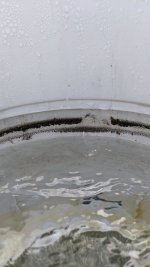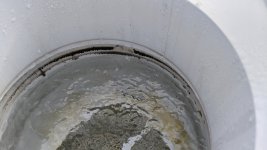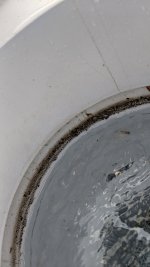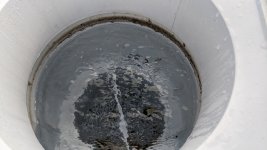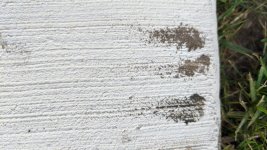I think most people try and top up the chlorine 3-4 times per day. Of course more is better. I’m not sure the amount of chlorine is any different in the end, but would be interested to hear if so.
Ok... so I've been thinking about the math behind adding chlorine throughout the day vs letting it drift to FC/CYA levels and then raising back to SLAM at night when the sun is not your nemesis. In the end, I think I've convinced myself that there's not a lot to be gained.
Disclaimer: What follows is based on mathematical inference, not actually science of chlorine loss or the effects of UV, etc.... I'm no
@chem geek !
It seems like a reasonable assumption for chlorine loss to the sun is something like 5% of FC per hour based on what I've read around here -- i.e. FC(t) = 0.95*FC(t-1). For a 25000 gal pool, at CYA = 50 and FC = 8, that equates to roughly 4.5ppm over the course of 16 hours. (8-8*0.95^16) That seems to be in keeping with the anecdotes here.
Using that same logic, then, starting at SLAM level 20, if I just let the sun do its thing for 16 hours, I end up at FC = 20*0.95^16 = 8.8 for a loss of 11.2ppm.
(For you math purists, I brushed up on my calculus a little: FC remaining at hour 't' = f(t) = FC*0.95^t ==> chlorine lost at the end of hour t = CL(t) = 0.05*f(t) = FC*0.05*0.95^t ==> chlorine lost over 16 hours = Integral_from0to15(CL(t))dt = FC*0.05*(0.95^15-1)/ln(0.95) = 10.46 ppm... so let's just go with the discrete method and say 11.2ppm is close enough!)
Compare that with dosing every hour to return to FC=20, which means I'm losing a constant 0.05*20 per hour for 16 hours ==> 0.05*20*16 = a loss of 16 ppm.
At face value, saving ~5 ppm = 1 gal of 12.5% bleach sounds like it may be a good idea... however if the algae is able to consume 2ppm over 8 hours at night, then figure it's good for at least 4ppm over 16 hours during the day. That would take my FC down to (20 - 11.2 - 4) = 4.8ppm, which may be too low for comfort if I don't want the algae to continue growing, which experience has shown it can even if FC is maintained at the high end of the normal FC/CYA range.
Ok then, add 5ppm at the start of the day to keep maintenance effort low but provide a buffer, so I start at 25 ppm, lose 14ppm (alright, 13.07 ppm if you really must) and end at a safer 11ppm. (7 after algae)
My intent would always be to start the night hours at the full SLAM level, so returning to 20ppm means adding back in the 9, plus the 4 that I'm assuming the algae will continue to consume during the day, yields a total addition of 5 + 9 + 4= 18 ppm with this approach.
Contrast that with adding 1ppm per hour for 16 hours if following TFP methods as aggressively as possible, and still assuming I lose 4 ppm to algae ==> 16 + 4 = 20ppm.
The "lazy" approach nets me a grand total savings of 2 ppm (half a gallon of 10% bleach... so $2-$3?).
Thus... it's not really saving money... although there's a decent argument to make that it's saving time and effort throughout the day, at the cost of increased risk of algae growth if the algae is still strong enough to be much more aggressive than 4ppm per day if left unmonitored. Again... this might only be even worth considering at the very tail end of the SLAM when such a bet that the algae is nearly beaten is safer... but it's still a gamble.
So.... the moral of the story is to keep following the TFP way, but don't stress as much if you can't hit the frequent small additions and opt for a few lesser but bigger additions?
Apologies for the long post... Hopefully my math is right. I'm sure people smarter than I will happily poke holes in it. Have at it!
 - the overnight chlorine loss test results are pointing to something hidden somewhere, somehow. Ladder cups/ bumpers perhaps? Are you certain of your cya level? Just spit balling here…
- the overnight chlorine loss test results are pointing to something hidden somewhere, somehow. Ladder cups/ bumpers perhaps? Are you certain of your cya level? Just spit balling here…


